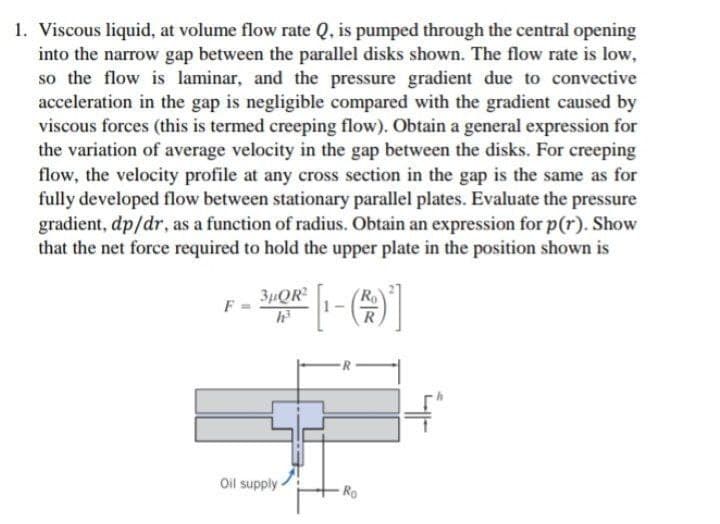Viscous liquid, at volume flow rate Q. is pumped through the central opening into the narrow gap between the parallel disks shown. The flow rate is low, so the flow is laminar, and the pressure gradient due to convective acceleration in the gap is negligible compared with the gradient caused by viscous forces (this is termed creeping flow). Obtain a general expression for the variation of average velocity in the gap between the disks. For creeping flow, the velocity profile at any cross section in the gap is the same as for fully developed flow between stationary parallel plates. Evaluate the pressure gradient, dp/dr, as a function of radius. Obtain an expression for p(r). Show that the net force required to hold the upper plate in the position shown is
Viscous liquid, at volume flow rate Q. is pumped through the central opening into the narrow gap between the parallel disks shown. The flow rate is low, so the flow is laminar, and the pressure gradient due to convective acceleration in the gap is negligible compared with the gradient caused by viscous forces (this is termed creeping flow). Obtain a general expression for the variation of average velocity in the gap between the disks. For creeping flow, the velocity profile at any cross section in the gap is the same as for fully developed flow between stationary parallel plates. Evaluate the pressure gradient, dp/dr, as a function of radius. Obtain an expression for p(r). Show that the net force required to hold the upper plate in the position shown is
Chapter2: Loads On Structures
Section: Chapter Questions
Problem 1P
Related questions
Question

Transcribed Image Text:1. Viscous liquid, at volume flow rate Q, is pumped through the central opening
into the narrow gap between the parallel disks shown. The flow rate is low,
so the flow is laminar, and the pressure gradient due to convective
acceleration in the gap is negligible compared with the gradient caused by
viscous forces (this is termed creeping flow). Obtain a general expression for
the variation of average velocity in the gap between the disks. For creeping
flow, the velocity profile at any cross section in the gap is the same as for
fully developed flow between stationary parallel plates. Evaluate the pressure
gradient, dp/dr, as a function of radius. Obtain an expression for p(r). Show
that the net force required to hold the upper plate in the position shown is
3µQR
F
R
Oil supply
Ro
Expert Solution
This question has been solved!
Explore an expertly crafted, step-by-step solution for a thorough understanding of key concepts.
This is a popular solution!
Trending now
This is a popular solution!
Step by step
Solved in 3 steps with 3 images

Knowledge Booster
Learn more about
Need a deep-dive on the concept behind this application? Look no further. Learn more about this topic, civil-engineering and related others by exploring similar questions and additional content below.Recommended textbooks for you


Structural Analysis (10th Edition)
Civil Engineering
ISBN:
9780134610672
Author:
Russell C. Hibbeler
Publisher:
PEARSON

Principles of Foundation Engineering (MindTap Cou…
Civil Engineering
ISBN:
9781337705028
Author:
Braja M. Das, Nagaratnam Sivakugan
Publisher:
Cengage Learning


Structural Analysis (10th Edition)
Civil Engineering
ISBN:
9780134610672
Author:
Russell C. Hibbeler
Publisher:
PEARSON

Principles of Foundation Engineering (MindTap Cou…
Civil Engineering
ISBN:
9781337705028
Author:
Braja M. Das, Nagaratnam Sivakugan
Publisher:
Cengage Learning

Fundamentals of Structural Analysis
Civil Engineering
ISBN:
9780073398006
Author:
Kenneth M. Leet Emeritus, Chia-Ming Uang, Joel Lanning
Publisher:
McGraw-Hill Education


Traffic and Highway Engineering
Civil Engineering
ISBN:
9781305156241
Author:
Garber, Nicholas J.
Publisher:
Cengage Learning